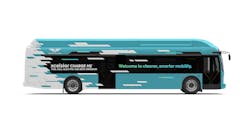Transit buses will power a first-of-its-kind vehicle-to-building resilience hub in California
A new pilot project in California will assess the use of electric buses as power sources for a resilience hub. The project, V2B Oakland, is funded by the California Energy Commission (CEC) and will demonstrate the value of bidirectional electric vehicle charging to support a first-of-its-kind vehicle-to-building (V2B) resilience hub.
This project will leverage stored energy from zero-emission electric buses, owned and operated by AC Transit, to provide filtered air conditioning at the West Oakland Branch of the Oakland Public Library for local residents in the event of unhealthy heat or smoke conditions. CEC’s Electric Program Investment Charge program awarded the project $3.2 million in funding, with combined $400,000 in matching funds contributed by West Oakland Environmental Indicators Project (WOEIP) and AC Transit. This pilot study will be executed by a project team consisting of the Center for Transportation and the Environment (CTE), The Mobility House, AC Transit, New Flyer, Schneider Electric, city of Oakland and WOEIP.
Each battery electric bus (BEB) will contribute six hours of backup power to the critical loads at the library and each hydrogen fuel cell-electric bus (FCEB) will provide up to 11 continuous hours of backup power, displacing nearly 100 pounds of carbon emissions per hour compared to traditional diesel backup generators. Working in close coordination with bus manufacturer New Flyer of America Inc. (New Flyer), a subsidiary of NFI Group Inc. (NFI), this project also marks the first time a U.S. transit agency will have the capability to use a hydrogen vehicle for V2B backup power.
“Initiating the first community resilience hub powered by a bidirectional V2B charging system has been an incredible journey. By bringing together leading-edge technological innovation and sustainability, we are able to offer much needed emergency response benefits for both transit agencies and communities,” said Jason Hanlin, director of Technology Research at CTE. “For a project with so many key players, we are excited to apply CTE’s proven project management approach to usher this novel project from concept to fruition.”
The resilient backup power system, which combines Bus Exportable Power Supply (BEPS) capability with bidirectional chargers and smart software, will be integrated and tested at NFI’s Hayward facility, then deployed at an AC Transit bus division and the Oakland Library. The system is designed to power the library’s upgraded HVAC and air filtration system, providing clean air and electricity inside the building to create a public shelter during emergencies and outages.
“We are thrilled to bring our ‘vehicle-to-everything’ expertise from numerous projects in Europe and Asia to now develop the first ever vehicle-to-building resilience hub in the U.S.,” said The Mobility House U.S. Managing Director Gregor Hintler. “Our ChargePilot system ensures all transit mobility needs are met and orchestrates the charge and discharge of the bidirectional chargers so that the buses can power critical building loads.”
Electric-drive bus fleets are uniquely suited for backup power and emergency relief because of their energy storage capacity, electrical architecture, independent mobility and ability to be quickly dispatched. When compared to diesel generators – the current default technology for emergency backup power – BEPS provides quicker response times; avoids emission of harmful pollutants; can be more cost-effective; and increases the value of procuring zero-emission vehicles and chargers by providing community support benefits.
“Powering emergency shelters with islanded energy supply is an innovative feat we are honored to help facilitate,” said Jana Gerber, president of Microgrids North America at Schneider Electric. “It is also exciting to demonstrate how different technologies can integrate with each other so seamlessly and intelligently to allow for crucial backup power for the community and infrastructure.”
“Unquestionably, delivering reliable public transit service to nearly 22 million annual riders is our highest priority but we also pursue partnerships and initiatives that advance zero emission technology," said AC Transit General Manager Michael Hursh. "V2B is one example of a zero-emission program that permits us to leverage our resources to enhance the resiliency and emergency preparedness of the diverse communities we've served for the past 60 years."
“NFI is proud to work with AC Transit and our other partners on this exciting project that enables our vehicles to act as generators supporting resiliency and emergency preparedness. This platform, the first vehicle-to-everything fuel cell-electric bus in the world, will change the game for electric propulsion technology and will vastly expand the capabilities and utility of our mobility solutions,” said Paul Soubry, president and CEO, NFI.
"Many low-income communities of color share streets and fence lines with the freight industry and suffer deadly pollution from petroleum combustion. With our electrical grids straining under the demands of global warming and solar and wind not keeping pace with the urgent need, hydrogen may offer another tool in the toolbox of zero-emission freight transportation opportunities. Communities like West Oakland will benefit from an expanded set of transportation energy options by getting cleaner, safer streets and air quality,” said Brian Beveridge, co-executive director of WOIEP.
Infrastructure is expected to be installed by mid-2023, and demonstration, analysis, evaluation and knowledge transfer for the pilot program will continue until July 2025
